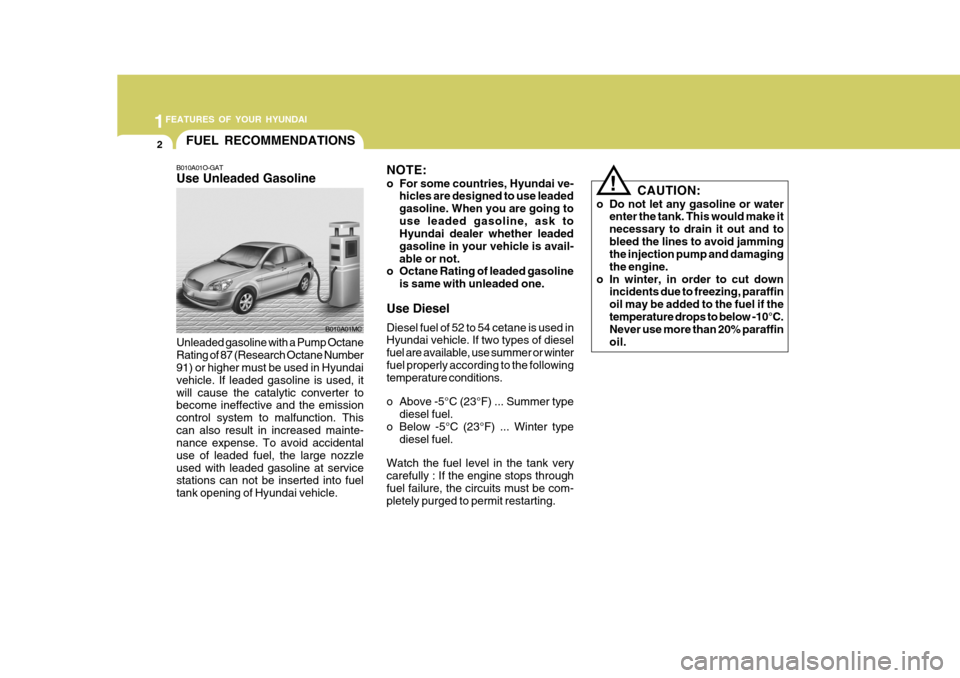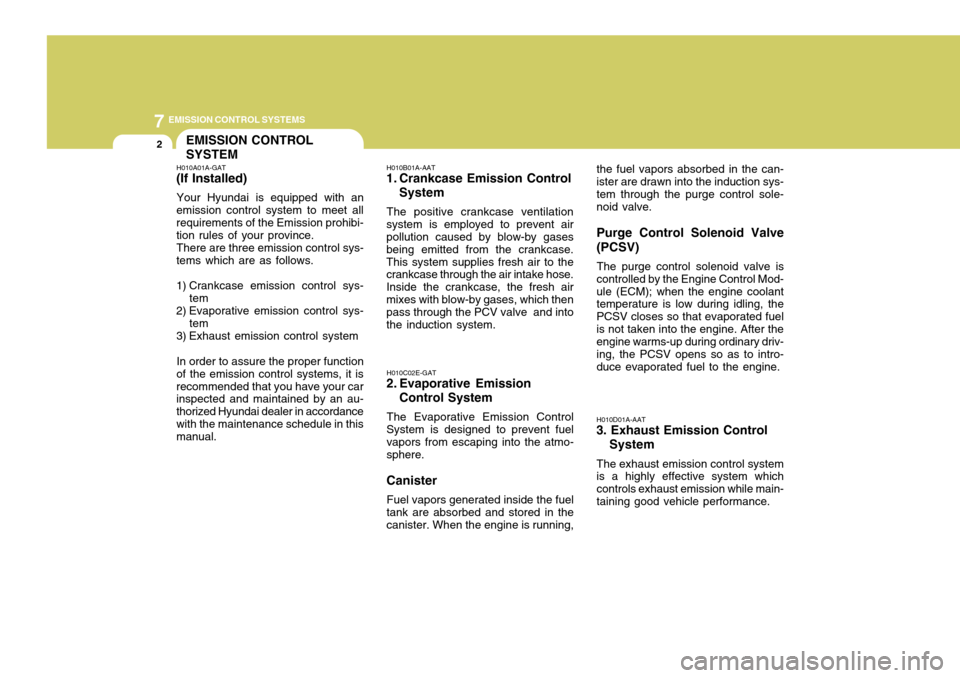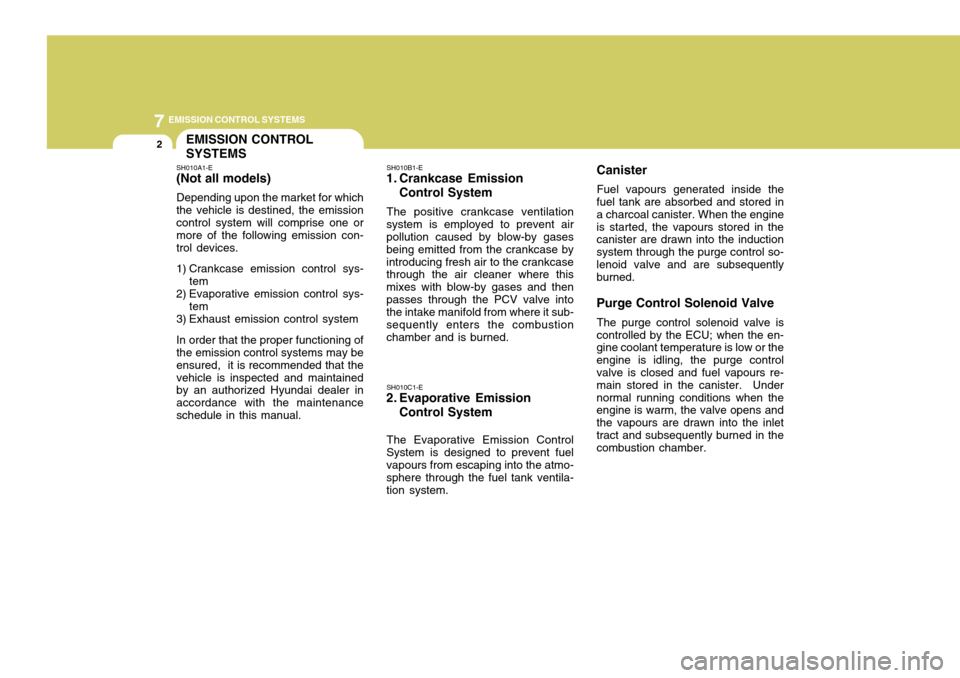open gas tank Hyundai Accent 2006 Owner's Manual
[x] Cancel search | Manufacturer: HYUNDAI, Model Year: 2006, Model line: Accent, Model: Hyundai Accent 2006Pages: 599, PDF Size: 17.59 MB
Page 16 of 599

1FEATURES OF YOUR HYUNDAI
2FUEL RECOMMENDATIONS
B010A01O-GAT Use Unleaded Gasoline NOTE:
o For some countries, Hyundai ve-
hicles are designed to use leaded gasoline. When you are going touse leaded gasoline, ask to Hyundai dealer whether leaded gasoline in your vehicle is avail-able or not.
o Octane Rating of leaded gasoline
is same with unleaded one.
Use Diesel Diesel fuel of 52 to 54 cetane is used in Hyundai vehicle. If two types of diesel fuel are available, use summer or winterfuel properly according to the following temperature conditions.
o Above -5°C (23°F) ... Summer type diesel fuel.
o Below -5°C (23°F) ... Winter type diesel fuel.
Watch the fuel level in the tank very carefully : If the engine stops throughfuel failure, the circuits must be com- pletely purged to permit restarting.
Unleaded gasoline with a Pump Octane Rating of 87 (Research Octane Number 91) or higher must be used in Hyundai vehicle. If leaded gasoline is used, itwill cause the catalytic converter to become ineffective and the emission control system to malfunction. Thiscan also result in increased mainte- nance expense. To avoid accidental use of leaded fuel, the large nozzleused with leaded gasoline at service stations can not be inserted into fuel tank opening of Hyundai vehicle. CAUTION:
o Do not let any gasoline or water enter the tank. This would make itnecessary to drain it out and tobleed the lines to avoid jamming the injection pump and damaging the engine.
o In winter, in order to cut down incidents due to freezing, paraffinoil may be added to the fuel if thetemperature drops to below -10°C. Never use more than 20% paraffin oil.
!
B010A01MC
Page 264 of 599

7EMISSION CONTROL SYSTEMS
2EMISSION CONTROL SYSTEM
H010A01A-GAT
(If Installed)
Your Hyundai is equipped with an
emission control system to meet all requirements of the Emission prohibi- tion rules of your province. There are three emission control sys-
tems which are as follows.
1) Crankcase emission control sys- tem
2) Evaporative emission control sys-
tem
3) Exhaust emission control system
In order to assure the proper function
of the emission control systems, it is recommended that you have your car inspected and maintained by an au- thorized Hyundai dealer in accordancewith the maintenance schedule in this manual. H010B01A-AAT
1. Crankcase Emission Control
System
The positive crankcase ventilation
system is employed to prevent airpollution caused by blow-by gases being emitted from the crankcase.This system supplies fresh air to the crankcase through the air intake hose. Inside the crankcase, the fresh airmixes with blow-by gases, which then pass through the PCV valve and into the induction system.
H010C02E-GAT
2. Evaporative Emission
Control System
The Evaporative Emission Control
System is designed to prevent fuelvapors from escaping into the atmo-sphere. Canister
Fuel vapors generated inside the fuel
tank are absorbed and stored in the canister. When the engine is running, the fuel vapors absorbed in the can-ister are drawn into the induction sys-tem through the purge control sole- noid valve. Purge Control Solenoid Valve (PCSV)
The purge control solenoid valve is
controlled by the Engine Control Mod- ule (ECM); when the engine coolant temperature is low during idling, the PCSV closes so that evaporated fuelis not taken into the engine. After the engine warms-up during ordinary driv- ing, the PCSV opens so as to intro-duce evaporated fuel to the engine. H010D01A-AAT
3. Exhaust Emission Control
System
The exhaust emission control system is a highly effective system which controls exhaust emission while main-taining good vehicle performance.
Page 284 of 599

1FEATURES OF YOUR HYUNDAI
2FUEL RECOMMENDATIONS
B010A01O-GAT Use Unleaded Gasoline NOTE:
o For some countries, Hyundai ve-
hicles are designed to use leaded gasoline. When you are going touse leaded gasoline, ask to Hyundai dealer whether leaded gasoline in your vehicle is avail-able or not.
o Octane Rating of leaded gasoline
is same with unleaded one.
Use Diesel Diesel fuel of 52 to 54 cetane is used in Hyundai vehicle. If two types of diesel fuel are available, use summer or winter fuel properly according to the followingtemperature conditions.
o Above -5 C (23 F) ... Summer type diesel fuel.
o Below -5 C (23 F) ... Winter type
diesel fuel.
Watch the fuel level in the tank very carefully : If the engine stops through fuel failure, the circuits must be com-pletely purged to permit restarting.
Unleaded gasoline with a Pump OctaneRating of 87 (Research Octane Number 91) or higher must be used in Hyundai vehicle. If leaded gasoline is used, itwill cause the catalytic converter to become ineffective and the emission control system to malfunction. Thiscan also result in increased mainte- nance expense. To avoid accidental use of leaded fuel, the large nozzleused with leaded gasoline at service stations can not be inserted into fuel tank opening of Hyundai vehicle. CAUTION:
o Do not let any gasoline or water enter the tank. This would make itnecessary to drain it out and tobleed the lines to avoid jamming the injection pump and damaging the engine.
o In winter, in order to cut down incidents due to freezing, paraffinoil may be added to the fuel if thetemperature drops to below -10°C. Never use more than 20% paraffin oil.
!
B010A03A
Page 583 of 599

7EMISSION CONTROL SYSTEMS
2EMISSION CONTROL SYSTEMS
SH010A1-E (Not all models) Depending upon the market for which the vehicle is destined, the emission control system will comprise one or more of the following emission con-trol devices.
1) Crankcase emission control sys-
tem
2) Evaporative emission control sys-
tem
3) Exhaust emission control system In order that the proper functioning of the emission control systems may be ensured, it is recommended that thevehicle is inspected and maintained by an authorized Hyundai dealer in accordance with the maintenanceschedule in this manual. SH010B1-E
1. Crankcase Emission
Control System
The positive crankcase ventilation
system is employed to prevent air pollution caused by blow-by gases being emitted from the crankcase byintroducing fresh air to the crankcase through the air cleaner where this mixes with blow-by gases and thenpasses through the PCV valve into the intake manifold from where it sub- sequently enters the combustionchamber and is burned.
SH010C1-E
2. Evaporative Emission
Control System
The Evaporative Emission Control
System is designed to prevent fuel vapours from escaping into the atmo- sphere through the fuel tank ventila-tion system. Canister
Fuel vapours generated inside the
fuel tank are absorbed and stored ina charcoal canister. When the engineis started, the vapours stored in the canister are drawn into the induction system through the purge control so-lenoid valve and are subsequently burned. Purge Control Solenoid Valve
The purge control solenoid valve is
controlled by the ECU; when the en- gine coolant temperature is low or the engine is idling, the purge control valve is closed and fuel vapours re- main stored in the canister. Undernormal running conditions when the engine is warm, the valve opens and the vapours are drawn into the inlettract and subsequently burned in the combustion chamber.